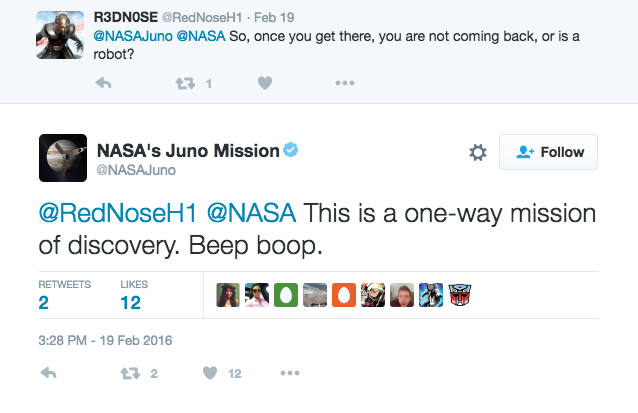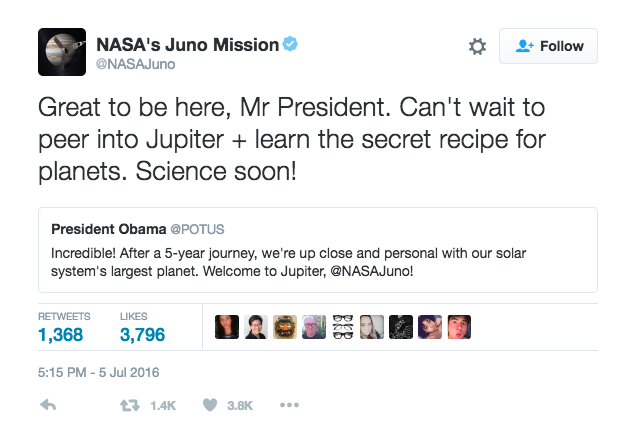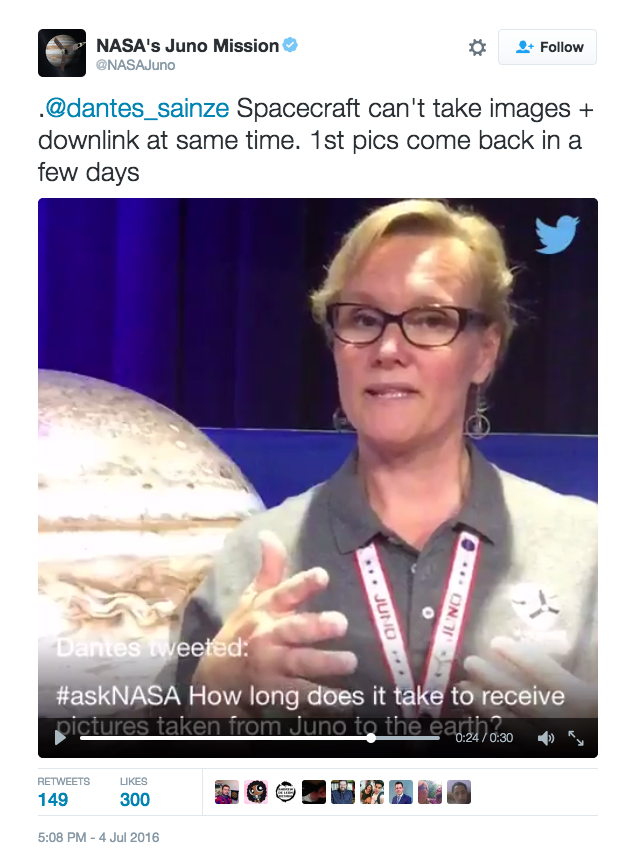“This is a one-way mission of discovery. Beep boop.”
When you think of the many successes of America’s space program, a few key moments come to mind.

John Glenn’s orbit around the Earth. Neil Armstrong’s first steps on the Moon. You remember these moments through the primary mediums of the day: print and television. Media has changed a little bit in the intervening decades. Organizations are telling their own stories rather than waiting to get coverage from The New York Times.
So when NASA’s Juno probe made it to Jupiter last week, the agency announced its arrival not with an article or a press conference, but with a tweet.

This government agency is becoming a great case study for success on social platforms, and Juno is just the most recent iteration of NASA’s social prowess. In an article for WIRED last year, Nick Stockton described how much social strategy matters to the organization:
“Social media strategy for us as a whole has been focused since 2009,” says John Yembrick, the agency’s social media manager. “We have over 500 social media accounts across the agency.” You’ve probably followed them, from astronauts and rovers to entire laboratories. NASA’s follower count across all platforms reaches well into the millions. The agency has actuallywonawards for its social media. NASA is a #brand.
Last year, for the arrival of the New Horizons probe at Pluto, the space agency debuted the first close-by image of Pluto on Instagram. And when astronauts go up to the International Space Station, they’re sharing their experiences in real time.
So when it comes to supporting the Juno mission, NASA pulls out all the stops across Facebook, Twitter, Instagram, and other social platforms. Their strategy — a strategy that can be emulated by any organization — centers on three core pillars: unique assets, personal voice, and community engagement with their experts.
Employ unique assets
NASA has identified the unique imagery, research, and information it can use to lead a wider conversation on space science and exploration. Critically to its success, it’s not locking these assets away in dense reports — NASA is taking its message straight to interested audiences.

Key Takeaway: Every organization has something unique to add to the social conversation. You might not have stunning imagery of far-away celestial bodies in your content arsenal, but for you, these assets could be data buried in an old report, or the unique experiences of your subject matter experts. The trick is figuring out which angle best fits your brand and which assets best support that angle.
Craft a personal voice
NASA is well known for the unique personalities of itsmissions and Juno is no different. Its voice, on Twitter in particular, that people can feel a level of connection and empathy with. Even the name of the mission is a bit of an inside joke.

Below: Juno seems to like to reference lyrics in several of its tweets. Maybe a reflection of its account manager?

Key Takeaway: You might feel that your subject matter is too dry to impact audience emotions in the way that NASA does, but few people want to converse with an impersonal brand. Mind you, this isn’t about appealing to Millennials or clamoring onto every trending hashtag and meme. No one cares what your organization has to contribute to #NationalFriedChickenDay unless that’s actually a fit for your brand. Give your mission a human voice — one that you might actually want to talk to yourself.
Lead with your experts
While you’re giving your mission a human voice, it’s helpful to actually lead with your humans … err … experts. Social platforms are often used as just another broadcast channel, which doesn’t really make best use of a social platform’s capabilities. NASA does a great job of pulling audiences into entertaining conversations with researchers and scientists.

Below: NASA does a great job of putting subject matter experts directly in touch with followers in Reddit AMAs.
Key Takeaway: Following on its brand voice, NASA makes its mission relatable and accessible for the wider public. You might have a hard time imagining the extent to which your audience will want to hear from your experts, but I guarantee you’re selling them short.




